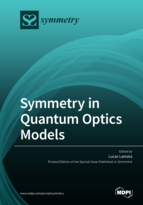Symmetry in Quantum Optics Models
A special issue of Symmetry (ISSN 2073-8994). This special issue belongs to the section "Physics".
Deadline for manuscript submissions: closed (31 July 2019) | Viewed by 23285
Special Issue Editor
Interests: quantum optics; quantum information; theoretical physics; quantum simulations; trapped ion physics; superconducting circuits; entanglement classification; entanglement generation; quantum biomimetics; artificial intelligence; machine learning; embedding quantum simulators; penning traps; quantum photonics
Special Issues, Collections and Topics in MDPI journals
Special Issue Information
Dear Colleagues,
Prototypical quantum optics models, such as for example the Jaynes–Cummings, Rabi, Tavis–Cummings, and Dicke models, are commonly analyzed with diverse techniques, including analytical exact solutions, mean-field theory, exact diagonalization, and the like. The analysis of these systems strongly depends on their symmetries, ranging, e.g., from a U(1) group in the Jaynes–Cummings model to a Z2 symmetry in the full-fledged quantum Rabi model.
In recent years, novel regimes of light–matter interactions, namely, the ultrastrong and deep-strong coupling regimes, have been attracting an increasing amount of interest. The quantum Rabi and Dicke models in these exotic regimes present new features, such as collapses and revivals of the population, bounces of photon-number wave packets, as well as the breakdown of the rotating-wave approximation. Symmetries also play an important role in these regimes and will additionally change depending on whether the few- or many-qubit systems considered have associated inhomogeneous or equal couplings to the bosonic mode.
Moreover, there is a growing interest in proposing and carrying out quantum simulations of these models in quantum platforms such as, e.g., trapped ions, superconducting circuits, and quantum photonics.
In this Special Issue, we intend to gather a series of articles related to symmetry in quantum optics models, possibly including, but not exclusively, the Jaynes–Cummings, Rabi, Tavis–Cummings, and Dicke models. We will also consider their generalizations to, e.g., inhomogeneous light–matter couplings, bias terms, time-dependent couplings, as well as all possible regimes of the light–matter interaction. We welcome papers on mathematical physics, related either to spectral analysis or time dynamics, as well as more applied articles with proposals for implementations of and/or experiments with these or related models in quantum platforms, such as trapped ions, superconducting circuits, and quantum photonics.
Prof. Dr. Lucas Lamata
Guest Editor
Manuscript Submission Information
Manuscripts should be submitted online at www.mdpi.com by registering and logging in to this website. Once you are registered, click here to go to the submission form. Manuscripts can be submitted until the deadline. All submissions that pass pre-check are peer-reviewed. Accepted papers will be published continuously in the journal (as soon as accepted) and will be listed together on the special issue website. Research articles, review articles as well as short communications are invited. For planned papers, a title and short abstract (about 100 words) can be sent to the Editorial Office for announcement on this website.
Submitted manuscripts should not have been published previously, nor be under consideration for publication elsewhere (except conference proceedings papers). All manuscripts are thoroughly refereed through a single-blind peer-review process. A guide for authors and other relevant information for submission of manuscripts is available on the Instructions for Authors page. Symmetry is an international peer-reviewed open access monthly journal published by MDPI.
Please visit the Instructions for Authors page before submitting a manuscript. The Article Processing Charge (APC) for publication in this open access journal is 2400 CHF (Swiss Francs). Submitted papers should be well formatted and use good English. Authors may use MDPI's English editing service prior to publication or during author revisions.
Keywords
- Quantum Rabi model
- Dicke model
- Mathematical physics
- Quantum simulations
- Trapped ions
- Superconducting circuits
- Quantum photonics
- Ultrastrong light–matter coupling regime






